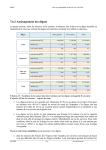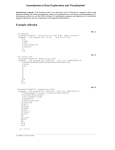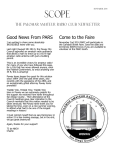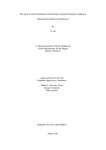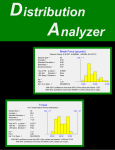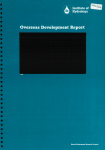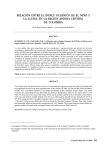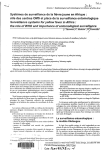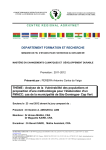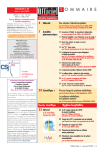Download world climate programme - water development, use and
Transcript
WORLD CLIMATE PROGRAMME - WATER DEVELOPMENT, USE AND APPLICATION OF THE HYDROSPECT DATA ANALYSIS SYSTEM FOR THE DETECTION OF CHANGES IN HYDROLOGICAL TIME SERIES FOR USE IN WCP-WATER AND NATIONAL HYDROLOGICAL SERVICES Report by Dr Maciej Radzeijewski and Professor Zbigniew W. Kundzewicz WCASP - 65 WMO/TD-No. 1240 (Poznan, June 2004) UNITED NATIONS EDUCATIONAL SCIENTIFIC AND CULTURAL ORGANIZATION WORLD METEOROLOGICAL ORGANIZATION The HYDROSPECT software and the manual can be downloaded from the following ftp site: ftp://www.wmo.int/documents/hwr/hvdrospect.zip Comments with regard to the HYDROSPECT software should be directed to Dr Maciej Radziejewski Research Centre for Agricultural and Forest Environment Polish Academy of Sciences ulBukowska 19 60-809 Poznan Poland E-mail: [email protected] NOTE The designations employed and the presentation of material in this document do not imply the expression of any opinion whatsoever on the part of the Secretariat of the World Meteorological Organization concerning the legal status of any country, territory, city or area, or of its authorities, or concerning the delimitation of its frontiers or boundaries. Editorial note: This report has been produced without editorial revision by the WMO Secretariat. It is not an official WMO publication and its distribution in this form does not imply endorsement by the Organization of the ideas expressed. Development, use and application of the HYDROSPECT data analysis system for the detection of changes in hydrological time series for use in WCP-Water and National Hydrological Services Final Report by Dr Maciej Radziejewski k. Professor Zbigniew W. Kundzewicz Poznan, June 2004 Hydrospect is a software package for detecting changes in long time series of hydrological records. The first version of the software was produced by Dr Maciej Radziejewski, under the supervision of Professor Zbigniew W. Kundzewicz in 1999, and reported in Radziejewski & Kundzewicz (2000). It was a contribution to the Project A.2 (Analysing Long Time Series of Hydrological Data and Indices with Respect to Climate Variability and Change) of the World Climate Programme-Water, prepared for the World Meteorological Organization in 1999. Based on remarks of the users of this software package and articulated needs for its extension, the present version of the package has been produced by the same authors. The most essential new elements of the brand new version of Hydrospect as compared to its first version of 1999 are: resampling, incl. block bootstrapping and block permutation, computing indices of extremes, tests for serial dependence, and support for extreme value analysis using POT (Peaks Over Threshold). Besides, the software was subject to a substantial general overhaul. The Hydrospect software and the manual can be downloaded from the following ftp site: ftp : //www. wmo. int/document s/hwr /hydrospect. zip Comments with regard to the Hydrospect software should be directed to Dr Maciej Radziejewski Research Centre for Agricultural and Forest Environment Polish Academy of Sciences ul. Bukowska 19 60-809 Poznan, Poland E-mail: maciejr@amu. edu. pi The new version of the Hydrospect software package has undergone testing by several users who made constructive comments, which helped the author to upgrade the product. Detection of changes in long time series of hydrological records is indeed an essential activity, both within the so called scientific hydrology and operational hydrology. Abrupt or gradual changes in river discharge are fundamental for planning of future water resources and flood protection. Traditionally, design rules are based on the assumption of stationary hydrology, resulting in the principle that the Past is the key to the Future, which has a limited validity in the era of global change (Kundzewicz, 2004). If the stationarity assumption is not correct then the existing procedures for designing water-related infrastructures: dams, dikes, etc. will have to be revised. Otherwise, systems would be over- or under-designed and might either not serve their purpose adequately, or be overly costly. The hypothesis that climate change leads to the acceleration of the hydrological cycle and may cause increases in the frequency and severity of extreme hydrological events has resulted in growing recent interest in change detection in flow data (Kundzewicz, 2004). Yet, there are problems with the availability of appropriate data to use, with the choice of methods to apply, and finally, with the interpretation of results. The search for (possibly) weak changes in time series of hydrological data, which are subject to (certainly) strong natural variability, is a difficult task, and the use of adequate baseline data (being in short supply) and of appropriate methodology is essential. The idea that all countries convey their hydrological data to global data repositories is excellent, but its implementation encounters considerable practical problems. Some countries, for several reasons, are reluctant to convey their data abroad, thus hampering international studies and jeopardizing ability to evaluate the components of the water balance of the world. Yet, if a uniform approach to change detection is taken, then countries may study their data at home and exchange the results. It is therefore essential that the methods of analysis used in different countries are comparable. When undertaking a study aimed at change detection in a hydrological variable one goes through the following steps — the main stages in statistical testing (Kundzewicz & Robson, 2004): • Decide what type of series to test depending on the issues of interest (e.g. monthly averages, annual maxima, deseasonalized data, etc). • Decide what types of change are of interest (gradual trend or step-change). • Check out data assumptions (e.g. use exploratory data analysis, or a formal test). • Select a statistical test (more than one is good practice). This means selecting a test statistic and selecting a method for evaluating significance levels. • Evaluate significance levels. • Investigate and interpret results. As stated above, selecting more than one test is a good practice. Hence results the usefulness of Hydrospect, containing several tests, which Situation Data are normally distributed, independent and non-seasonal Guidelines for test selection This is an unlikely scenario for hydrological data. If applicable, all tests used in the area should be suitable. Any of the distribution-free tests are suitable. Tests that are based on normality assumption can Data are independent also be applied, either by (a) first applying a norand non-seasonal, but mal scores or ranks transformation, or (b) using are non-normal a relevant test statistic and evaluating significance using resampling techniques. For almost all the tests, it will be necessary to Data are non-normal, extract the test statistic, and then to evaluate siand are not indepen- gnificance levels using block-permutation or blockbootstrap methods. Without this, test assumpdent or are seasonal tions will not be met. TABLE 1. Guidelines for test selection — general applicability of tests (after Kundzewicz h Robson, 2004). lend themselves well to application in hydrological context. The selection of a test from the available set of methods (e.g. present in Hydrospect) for a particular situation (properties of data) can follow the guidelines encapsulated in the following table (from Kundzewicz &; Robson, 2004). The present Report contains the User's Manual to the Hydrospect software package (version 2.0) as Appendix. It is expected that the Hydrospect package will be of considerable use in the World Climate Programme-Water and in National Hydrological Services of WMO Member Countries. References Kundzewicz, Z.W. (2004) Searching for change in hydrological data. Hydrol Sci. J. 49(1), 3-6. Kundzewicz, Z. W. &; Robson, A. J. (2004) Change detection in river flow records-review of methodology. Hydrol. Sci. J. 49(1), 7-19. Radziejewski, M. h Kundzewicz, Z.W. (2000) Hydrospect - Software for detecting changes in hydrological data. Appendix 2 in: Kundzewicz, Z. W. h Robson, A. J. (eds.) Detecting Trend and Other Changes in Hydrological Data. World Climate Programme-Water, World Climate Programme Data and Monitoring, WCDMP-45, WMO/TD no. 1013. World Meteorological Organization, Geneva, Switzerland. Appendix User's Manual Hydrospect, Version 2.0 Maciej Radziejewski & Zbigniew W. Kundzewicz June 2004 Contents Chapter 1. Overview of Hydrospect 1. New features in version 2.0 2. System requirements and installation 6 7 8 Chapter 2. Working with data files 1. Data file format 2. Import options 3. Simulating Hydrospect 1.0 data file reading mode 4. Viewing the data 5. Exporting a time series 9 9 12 13 14 14 Chapter 3. Statistical tests 1. Tests for changes 2. Tests for serial dependence 3. How to interpret results? 4. Resampling 16 16 21 23 24 Chapter 4. Working with time series 1. Aggregation and indices of extremes 2. Computing ranks 3. Computing normal scores 4. Peaks over threshold 5. Selecting a subseries 6. Analysis of changes in variance 7. De-seasonalisation 26 26 31 31 32 32 33 33 Chapter 5. Saving and sharing your work 1. Hydrospect documents 2. Reporting the results 35 35 35 Chapter 6. Reference 1. Keyboard shortcuts 36 36 Bibliography 37 CHAPTER 1 Overview of Hydrospect Hydrospect is a software package for detecting changes in long time series of hydrological data. It makes use of a set of eight different tests for change detection and lets the user create customized derived series to analyse changes in different aspects of time series behaviour. The significance of changes may be computed with standard test formulae or using several resampling techniques, including block permutation and block bootstrapping. Hydrospect is easy to learn and use. It is a tool specifically designed for time series analysis. It allows you to: • read time series data from text files in a variety of formats, see Section 1 of Chapter 2, page 9; • aggregate the time series using a variety of indices, see Section 1 of Chapter 4, page 26; • compute a POT series, see Section 4 of Chapter 4, page 32; • compute ranks and normal scores, remove the annual cycle, select a sub-sequence, etc.; • study changes in various characteristics of a time series using statistical tests and resampling. You may also like to use Hydrospect in conjunction with other tools using only a subset of its features, for example you may extract data from a text file in an unusual format using Hydrospect's robust data import mechanism or compute annual indices of extremes or POT series, and save the resulting time series in a simple text file for further study with another application. Hopefully it will make a useful addition to your toolbox. Hydrospect will perform computations efficiently and without consuming more system resources than necessary. It includes numerous "extra features" that do not make the user interface more complicated and turn out very useful in practice. For example: (1) You can enter fractional parameters in many places where you would normally expect only integers would be allowed. For instance, when you compute annual means out of a daily time series not tagged by any dates, you may just enter "365.25" as period length and Hydrospect will use periods of length 365 and 366 in turns, so that the mean period length will indeed be 365.25. 1. NEW FEATURES IN VERSION 2.0 7 (2) Hydrospect recognizes and properly handles missing values and ties in the data (ties influence the values of some statistical tests, some resampling techniques, ranks, etc). (3) When importing data from a text file, Hydrospect analyses the file and determines where the data may be located, what separators were used, etc. You only need to choose the data column you wish to use. This version of the program is still limited to time-series analysis. Several variables may be analysed, but each one is analysed separately. Multivariate analysis may be possible in future versions. For now, if you require such facilities, you may still be able to benefit from using Hydrospect in combination with other programs to achieve your goal. Hydrospect may be useful to pre-process your data (which may then be exported, i.e. saved in a text file) and to evaluate partial or final results. The source code of Hydrospect, Version 2.0, has been written in Visual C++. The package delivered to users consists of the executable programme file hydrospect.exe, and the present User's Manual in PDF format (the "two-side" version is formatted for two-sided printing). Hydrospect is a contribution to the Project "Change Detection in Hydrological Data" of the World Climate Programme - Water, prepared for the World Meteorological Organization. This software was developed by Dr Maciej Radziejewski under supervision of Professor Zbigniew W. Kundzewicz. 1. New features in version 2.0 Major new features in Hydrospect 2.0 are the following: • tests for serial dependence, see Section 2 of Chapter 3, page 21, • resampling, see Section 4 of Chapter 3, page 24, • indices of extremes, see Section 1 of Chapter 4, page 26, and • POT (Peaks Over Threshold), see Section 4 of Chapter 4, page 32. Some previously existing features have been improved: • missing values are more visible (displayed as blank cells in time series preview pane); • a toolbar button with the letter "M" becomes available when missing values are present to quickly inform you about that and let you hide/show them; • more convenient data file import interface with a summary of not interpreted lines; • a possibility to treat some numeric constants as missing values in data files (e.g. -9999.00); • when data files loaded by a document cannot be found, Hydrospect searches for them in the document's directory (useful 2. SYSTEM REQUIREMENTS AND INSTALLATION 8 when you moved your document and data files to another machine); • the percentage of missing values allowed in an aggregation period is now user-definable; • Hydrospect remembers more of the parameters you entered or choices you made and makes them defaults for later. A short description of the previous version of Hydrospect can be found in [9]. 2. System requirements and installation Hydrospect should work well on every PC with Microsoft Windows 98 or later and Microsoft Internet Explorer 5.0 or later installed. Although Hydrospect does not use Internet Explorer in any way, it makes use of some basic components of Windows that are updated along with Internet Explorer. Most probably you will be able to use Hydrospect right away without any preparatory steps, but if you experience difficulties getting it to start, please try to install the newest available version of Internet Explorer on your system. Hydrospect does not require any installation. The program file can be run from any location. You may also place it in the standard system folder, e.g. C:\Program Files, and create a shortcut to it on the desktop or in the Start menu. CHAPTER 2 Working with data files Before you can do anything useful with Hydrospect, you need to load, i.e. "import", a data file. When you start the program, a message displayed in the program window prompts you to do so. Creating or directly editing the data set is not supported within Hydrospect. However, a number of built-in functions let you transform your data in a variety of ways. If you need to make direct changes (for example correct errors), you can do it with another tool, e.g. a spreadsheet, and then use the altered file, rather than the original one, with Hydrospect. To load a data file: • choose Time series, Import new data file from the menu, or • choose File, Import new data file from the menu, or • click the button with a green triangle on the toolbar You will be given the opportunity to pick the file of your choice and to decide which columns in the file contain the time series you wish to study. The details are given below. 1. Data file format Hydrospect can read data from text files. The import feature has been designed for flexibility, so that it will, most probably, be able to read your existing data files without special preparation. The requirement is, that the lines containing time series data — dates (and/or times) and values — follow a uniform pattern. That is, each of them has the same number of values and dates, in the same order, and corresponding dates are in the same format, i.e. consist of the same number of fields and use the same separators. In fact, a "date" does not have to look like 1972/05/21 or 1972-21-05. It can also be 1972-21-05:09:30:54 or, in general, any sequence of natural numbers separated by any of the following characters: - : . / \ with one exception: two numbers separated by a dot (like 1972.05) do not form a legitimate date, since they might be confused with a decimal fraction. You can also use multiple date-time entries, so 1972-21-05 09:30:54 is ok, too. Finally, an integer number can also 1. DATA FILE FORMAT 10 be treated as denoting date-time information. This allows using dates like 1987 11 30. An index denoting, e.g., the number of days since January the l9t, 1900, is also a valid date field. Time series values must be specified as integer or floating-point numbers. Exponential notation (using e or E) is ok, too. Hydrospect always uses a dot as the decimal point, regardless of the regional settings of your operating system, in order to assure compatibility of data files between different systems. Values and dates in each line must be separated by blank characters (spaces or TABs), commas or semicolons. The column width does not have to be fixed in Hydrospect. Fixed-width data files can be read properly, because multiple blank characters are treated as one. A file may contain an arbitrary number of date and value columns, but you will only be able to import one value column (and multiple date columns) at a time. Missing values should preferably be represented as blank spaces delimited by commas or semicolons (since multiple spaces or TABs are treated as one, there is no way to have a blank space delimited by other blank spaces). Optionally, a special numeric constant (e.g. —9999.00 or a similar constant of your choice) may also be interpreted as a missing value. That is the only way to specify missing values in a fixed-width data file without delimiters. Please note that missing values in date/time columns are not allowed. Data files often contain comments or headers that can be quite long and sometimes appear even in the middle of the file. In such a case Hydrospect tries to find a common pattern among a majortiy of the lines in the file. The lines following the pattern are treated as data lines, and the other ones as comments. It is important that comment lines can be clearly distinguished from data lines, either by that they contain some text or (at least) have a differrent number or format of entries. Some comment lines may have special meaning: the first line may contain a descriptive "name" of the dataset in the file; the line preceding the first data line may constist of column headings (as in a table), i.e. one-word names for each column. Dataset name and/or column headings can form a default name for your time series displayed in the program window. Dataset name can be quite long, to identify the data unambiguously. It is practical to put the most essential part of the name at the beginning, for example "Warta monthly mean flows, 1822-1990", rather than "Monthly meanflowsof the river Warta, 18221990". Example 1. A simple time series of daily river flows accompanied by dates including calendar years and hydrological years can be easily imported. Alph r i v e r daily flows, in cubic meters per second. 1980 10 29 1980 210.4 1. DATA FILE FORMAT 1980 1980 1980 1980 10 10 11 11 30 31 01 02 1980 1980 1981 1981 11 181.0 123.9 299.3 312.0 Hydrospect will analyse the file and suggest correct defaults for the interpretation of date/time and flow data columns. Example 2. A file containing several variables should preferably contain column headings describing the variables. Ground temperature in the town of Xanadu Year, Month, Day, Tmax, Tmin 1999, 11, 01, 12.0, 8.5 1999, 11, 02, 11.9, 7.5 1999, 11, 03, 8.0, 5.0 Hydrospect will recognize the date/time columns and suggest the first likely time series values column (Tmax in this case). You can choose to import either Tmax or Tmin. Example 3. Data from a regional climate model is stored in large files. Each file contains daily Tmax temperatures for 360 days in 11766 ground-level cells of the model (the cells form a rectangular grid 106 x 111) in the following order: first, all the data for the first day, then for the second day, and so on. The data for each day were arranged to 10 columns (wrapped) for "easy" handling with Fortran programs, therefore each day's data consists of 1176 lines with 10 values each and one more line with 6 values. Each day's data is preceded by a header. Year= 2070 Month» 1 Day= 1 Daily max temperatures (K) 11766 Format is 10F8.2; missing value is 290.00 291.00 292.00 280.00 293.00 295.00 291.00 292.00 280.00 293.00 295.00 294.00 292.00 291.00 290.00 291.00 292.00 280.00 9999.99 294.00 292.00 292.00 292.00 293.00 295.00 292.00 291.00 294.00 291.00 290.00 292.00 292.00 280.00 293.00 295.00 294.00 292.00 Year= 2070 Month=> 1 Day*» 2 Daily max temperatures (K) 11766 Format is 10F8.2; missing value is 9999.99 280.00 293.00 295.00 294.00 292.00 292.00 291.00 290.00 291.00 292.00 Suppose you were asked to extract data for just one cell, say cell No. 5378, from such a data file. In other words, you wish to extract the value in row 538, column 8 from each day's data. Hydrospect will analyse the file (you need an apropriate amount of memory, slightly more than the size of the file) and ignore the headers at the beginning and in the middle of the file. The non-fitting lines with 6 values at the end of each day's data will have to be ignored as well and there is no way to read those with Hydrospect without reformatting the file. You will need to select column 8 for your time series. Hydrospect will load 2. IMPORT OPTIONS 12 all the values from column 8. Then, to select only the values in row 538 out of 1176 rows for each day, you can create a subseries of your imported series, cf. Section 5 of Chapter 4, page 32. 2. Import options After you choose the Import new data file command from the Time series menu, Hydrospect lets you select and open the data file, analyzes it to find where the data is located in the file and how it is formatted, and then displays a dialogue box with some options. You can type the name of your dataset in the appropriate field or accept the default one that Hydrospect suggests: either the first line of the file (unless it is recognized as data) or the file name. If Hydrospect recognizes column headings (cf. the previous section) you may choose to use them, too. In that case the column heading corresponding to your selected time series will be appended to the dataset name to form the name of the time series displayed in the program window. The box Data preview contains initial data lines in the file. You can select a column with the time series you wish to study and as many date/time columns as you like by clicking on the headings in this box. Possible selections are: time, data, and skip. Note that for some columns Hydrospect cannot determine if they contain time series values or date/time info, so both choices time and data are available. It is best to select all the relevant date/time entries, but you will only be able select one column for time series values (data). Below the box, Hydrospect displays a summary of unused comment lines, if any. Presence of such lines may indicate that valid information could not be read or that the file is corrupted, particularly if they are present in the middle of the file. You can view the unused comment lines at the beginning and within the file by clicking on the underlined parts of the summary. If you find that a valid data line is to be ignored, it means that formatting of data is not uniform, so you may need to reformat your data, or that the file contains an error — in that case you may try to correct it. Hydrospect displays each ignored line with a line number at the beginning. The last option is to specify a special code denoting a missing value. It must be a valid floating-point or integer number. Hydrospect will check for this value using literal (i.e. textual, not numerical) comparisons, so there is no danger of accidental misinterpretation because of floating-point rounding errors. After you have set the options, you can press the OK button. The time series is loaded and its name appears in the left pane. You can click on the name with the right mouse button and choose Options if you wish to change the import options. If the import has failed, a replacement name is displayed in bold. Changing the options may then allow you to read the series successfully or pick a different data file. 3. SIMULATING HYDROSPECT 1.0 DATA FILE READING MODE 13 The contents of your data file are not stored in the Hydrospect document, and will have to be read every time the document is opened. Only the options you selected are stored. In fact, if you replace the original file with another file having the same structure, and then open the document, the original analysis will be repeated for the new file. If you click the series name with the right mouse button and choose Delete, or if you press the Delete key after selecting the series, you are given the option to remove it from the Hydrospect window. This only means that Hydrospect will stop using it but it will not be deleted from the disk. 3. Simulating Hydrospect 1.0 data file reading mode There is a very minor difference in the way Hydrospect 2.0 and the previous version, Hydrospect 1.0, treat data files. If you used Hydrospect 1.0 before, and open documents created with it Hydrospect 1.0 in Hydrospect 2.0, you may wish to turn on the Simulate Hydrospect 1.0 menu option available through the File, Data file reading mode menu entry. To restore the standard behaviour, please select the Standard option from the same menu. The only difference between the two modes is how the lines ending with a comma or semicolon are treated. Normally a line like: 10, should be treated as consisting of two fields, the second one being a missing value, so data structure like the following: 9, 3.0 10, 11, 2.1 would be ok. Hydrospect 1.0 would only recognize such a line properly if there were any spaces after the comma — a comma or semicolon at the very end of the line would be ignored. This (unintentional) behaviour was changed in Hydrospect 2.0 and now a comma or semicolon is always taken into account. However, if you relied on this (undocumented) behaviour in Hydrospect 1.0, you may have created / used data files formatted like this: 9, 3.0; 10, 5.5; 11, 2.1 i.e. with some lines ending with a separator and other not so (this is not a good practice). In the Standard mode Hydrospect 2.0 would disregard some of those lines as not consistent with the common pattern in the file. Information about such disregarded (ignored) lines is displayed when you import a new data file (see the previous section). However, when you open an existing document, you may receive no warning of some lines being disregarded unless you choose to review 5. EXPORTING A TIME SERIES 14 and / or reselect the import options (cf. the previous section). Therefore Hydrospect provides a "compatible" mode in which data are read in exactly the same way as before. In any case, it is a good idea to review the import options for every time series in a document created by Hydrospect 1.0 and examine the ignored lines to make sure that your data file was correctly read. The Standard option is recommended to use unless absolutely necessary Using both options interchangeably might result in some data being ignored without warning. 4. Viewing the data When the time series is successfully read, its name appears in the left pane of the program window and the series itself is presented in the lower pane, on the right. If the name is not entirely visible, you can position the mouse pointer over it and a "tool-tip" will appear, showing all of the text. When you click on the lower right pane to activate it, one of the rows will be selected and the row number will appear on the status bar, at the bottom of the window. You can move back and forth through the data using the scroll-bar and the keyboard (Up/Down arrow keys, PageUp, PageDown, Home, End) to make sure the data in the file have been interpreted correctly. If there are missing values in the time series, they will normally appear as blank cells. Presence of missing values activates the toolbar button with the letter "M" that acts as a switch: it lets you hide all missing values in the time series. It only affects the display, not the computations or underlying data. The menu entry View, Show missing values has the same function. You can import as many series as your computer's memory permits. Selecting one of them (e.g. with a mouse click) will bring it into focus and its data will appear in the lower right pane. 5. Exporting a time series If you wish to study a time series with another program (e.g. to create a graph), you can save it in a text file. To save a time series in a text file: • select the series and choose Time series, Export, or • select the series and choose File, Export the time series, or • click the series name with the right mouse button and choose Export Then you can enter the name of the file to hold the data and click the Save button to complete the process. There is little merit in exporting a raw file you have just imported, but, as will be described later on in the manual, Hydrospect allows you 5. EXPORTING A TIME SERIES 15 to perform a number of operations on a time series, i.e. derive new series from existing ones, and those derived series might be of some use elsewhere, too. CHAPTER 3 Statistical tests To perform a test on a time series, select its name in the left pane of the program window. The time series should appear in the lower right pane (data view). The upper right pane will contain the list of tests performed on this series. You can choose an entry from the Test menu to add a test of your choice to the list. To add a test to the list: • select a test from the Test menu, or • click on the list of tests with the right mouse button and choose a test from the context menu If a menu item is greyed, the particular test is not available for the time series presently selected. Some tests can only be applied to a series of ranks or ranked deviations from the median. Please look at the test's description (in one of the following sub-sections) before using it. Most tests will be added to the list with default options, so you will not be bothered with a dialogue box every time you add a test. To change the options, you can click on the appropriate list entry with the right mouse button and choose Options from the context menu that appears. Alternatively, you can double-click the list entry or, after the list entry is selected, you can press Enter to access its options. You can also press the Delete key or choose Delete from the context menu to remove the test from the list. If you wish to remove all the tests performed for this time series, follow the same procedure for the heading of the list. Brief descriptions of the tests available in Hydrospect are given in the following sub-sections. For more detailed information about testing for changes, including the theoretical foundations and detailed discussion of the properties and applicability of various tests, please refer to [7] and to the original sources, cited in the text. A short review of tests can also be found in [14]. 1. Tests for changes 1.1. Linear regression. The test statistic is the correlation coefficient (also called Pearson's r) of the time variable and the observations. Optionally the slope of the fitted line and the significance level are also 16 1. TESTS FOR CHANGES 17 computed. The significance level (cf. [15, 3, 11]) is valid under the null hypothesis of independent and normally distributed observations. The test statistic is the correlation coefficient between the time variable and the values of the time series. If n is the length of the time series and a i , a 2 , . . . , a n denote the time series values, then the test statistic is defined as r = 1 = vv * n ^(o,-m)(t-m*), t=i where 1^ n m lA n i n t=i and n Vt n < = l If there are missing values in the series, the above sums are computed only over the values of t such that at is not missing, and ~ is replaced by ^7 where n' is the number of non-missing values in the series. In presence of missing values regression can still be performed and the correlation coefficient of time and observations computed based on the data available. However, the significance level computed using the standard formula may not be valid in this case, so it has to be computed using resampling (cf. the corresponding section later on in this chapter). 1.2. Normal scores linear regression. This is a non-parametric test based on linear regression. To run it for a certain time series, derive normal scores (cf. Section 3 of Chapter 4, page 31, and [10]) from the series and apply the linear regression test to the derived series. The significance level is valid only under the null hypothesis of independent, identically distributed observations in the series from which normal scores are derived. This test is particularly useful for detection of gradual change in time series. 1. TESTS FOR CHANGES 18 1.3. Spearman's rank correlation. This non-parametric test involves applying linear regression to the series of ranks [8]. To compute it in Hydrospect, derive a series of ranks from your time series (cf. Section 2 of Chapter 4, page 31) and perform the linear regression test. The significance estimate is based on the Student's t distribution as in [8]. It is valid under the null hypothesis of independent, identically distributed series values. This test is particularly useful for detection of gradual change in time series. 1.4. Mann-Kendall's test. This is a robust non-parametric test based on the "tau" statistic introduced by Kendall [4]. Kendall's tau was adapted by Mann to time series analysis (cf. [11] and [14]). In Hydrospect this test can only be applied to a series of ranks or ranked deviations from the median, so the raw data need to be pre-processed and ranks calculated. Please refer to Section 2 of Chapter 4, page 31, for details on computing ranks with Hydrospect. The test statistic displayed is Kendall's sum (commonly denoted as S) divided by the square root of its variance under the hypothesis of independent and identically distributed observations. If n is the length of the time series and oi, 02,..., an denote the time series values, then the test statistic equals ±s where S= ^2 sgn(aj - a*), l<i<j<n and n(n-l)(2n + 5) v— 18 unless there are ties (equal values) present in the data, in which case the formula for variance given in [5] is used. The significance level is valid under the null hypothesis of independent and identically distributed observations. As an option, Kendall's original tau (the sum S divided by the maximum possible value of S obtainable by a rearrangement of the time series values) is also displayed. If there are missing values in the time series, the Mann-Kendall's test is applied to the non-missing values, as if they were consecutive in the series. Hydrospect employs a dedicated algorithm for computing this test efficiently, in the order of n log n operations, where n is the series length. This test is particularly useful for detection of a gradual change or trend in time series. 1. TESTS FOR CHANGES 19 1.5. Distribution-free CUSUM. This non-parametric test is implemented, in general case, as in [2]. The test statistic is KS defined in [2]. If n is the length of the time series and oi, 02,..., a n denote the time series values, then the test statistic satisfies the formula: \KS\ = - max ^ s g n ( a i - M ) 71 l<fc<n i=l where M denotes the median of time series values, and the sign of KS matches the sign of the corresponding inner sum for which the maximum absolute value was reached. This test is based on the assumption that the number of values in the series below the median and the number of values above the median are the same. In case of ties, specifically if values equal to the median are present in the series, this might not be true. In this case, distinct weights are used for the values above and below the median to make sure that the total cumulative sum is unbiased and the assessment of significance by means of the Kolmogorov-Smirnov test is valid. The weights for each group of values are equal to the reciprocal of their quantity, analogously to [2]. If there are missing values in the series, the Distribution-free CUSUM test is applied to the non-missing values, as if they were consecutive in the series. Significance level computed is valid under the null hypothesis of independent, identically distributed values. As an option, the point k at which the cumulative sum was greatest is also displayed. 1.6. Cumulative deviations. This parametric test is described in [1], [2] and [14]. The test statistic is the value denoted by Q in those papers. If n is the length of the time series and 01, c&2,..., an denote the time series values, then the test statistic equals: Q — — maxY^{a>i ~ m) <J \<k<n i=l where m is the mean of time series values, and a is the standard deviation. Significance level is computed according to the limit distribution (valid for long time series) given in [1]. For series of 100 observations or shorter, Buishand [1] gives a table of percentage points for the statistic divided by the square root of the series length. This measure can also be computed here as an option, so the significance can be easily looked up in the table. The same table is reproduced in [14], although it appears under a different heading. Please note that you do not need to use such a table if you compute the significance using resampling, cf. Section 4 of Chapter 3, page 24. 1. TESTS FOR CHANGES 20 If there are missing values in the series, the Cumulative deviations test is applied to the non-missing values, as if they were consecutive in the series. Both the limit distribution significance estimate and the tables of percentage points are valid under the null hypothesis of independent, normally distributed observations. Another option is whether or not to display the estimated changepoint, i.e. the point k where the accumulated deviation from the mean was largest. 1.7. Worsley's likelihood ratio. This is a parametric test defined in [16] and described also in [14], [2], and [1]. The test statistic is denoted as W in each of the above sources. If n is the length of the time series and ai,02,...,a n denote the time series values, then the test statistic equals: W =V n-2 1_y2' where 1 T/ k V = \<k<n-i max ay/i(n - i) m is the mean of time series values, and a is the standard deviation. If there are missing values in the series, the Worsley's likelihood ratio test is applied to the non-missing values, as if they were consecutive in the series. There is also an option to compute the equivalent V statistic. The change point estimate is also displayed as an option. A table of percentage points for W, for series of 50 observations or shorter, under the null hypothesis of independent, normally distributed observations, is given in [16]. This test is particularly useful for detection of abrupt step change in time series. 1.8. Kruskal-Wallis test. This is a non-parametric test for equality of subperiod means. It was introduced in [6] and described also in [2] and [14]. In Hydrospect this test can only be applied to a series of ranks or ranked deviations from the median, so the raw data need to be pre-processed and ranks calculated. Please refer to Section 2 of Chapter 4, page 31, for details on computing ranks with Hydrospect. This test is based on partitioning the time series to subperiods of possibly differing lengths. For each subperiod, the mean of ranks of values within the subperiod is calculated. If n is the series length, m the global mean of ranks, N the number of subperiods, n^ the number of values in the i-th. subperiod, and m* the mean rank for the i-th subperiod, then the test statistic equals: 12 A H= B ( B + 1 ) T ^ . L*-m). 2. TESTS FOR SERIAL DEPENDENCE 21 where T is the "tie correction" : T -éî^-*" tj denoting the number of ties in subsequent tie groups. If missing values are present in the series, subperiod means are computed based on non-missing values. The partitioning of the series to subperiods is based on the period starting points entered in the dialogue box, separated by spaces. For example, if you would like to test for equality of the means of subsequent 30-year periods in a 90-years-long time series of annual mean temperatures, you need to compute the series of ranks, add the Kruskall-Wallis test from the Test menu, and specify 1 31 61 to define three subperiods: years Nos. 1-30 (the first 30 years), years Nos. 31-60, and years Nos. 61-90 in the time series. Equivalently you can specify 31 61, because the first subperiod always starts from the first value, so the leading "1" is redundant. If you would like the period to start at a given date and do not know the corresponding number to enter in the dialog box, you can highlight the desired time series value in the data view. The value number (position) in the time series will be displayed on the status bar, next to Selected position. This is the number you should enter in the dialogue box to make this observation start a new subperiod. The Auto-fill button simplifies defining subperiods, by filling the Sub-period starting points field: • press Auto-fill when the field is empty, to fill it with values dividing the time series in three parts • enter one number (period length) in the field and press Autofill to divide the series to periods of the given length • enter more numbers separated by spaces and press Auto-fill to extend the sequence of numbers entered in the arithmetic progression based on the last two numbers There is also an option to compute the significance level (valid under the null hypothesis of independent, identically distributed values). 2. Tests for serial dependence Before you use any of the change-detection tests described in the previous section you have to make sure you are using an appropriate method and that the assumptions made by the methods are satisfied. Typically change-detection tests make two kinds of assumptions: • independence of observations (e.g. daily mean flows of a large river are very unlikely to be independent while annual mean flows often are) • normally distributed observations. 2. TESTS FOR SERIAL DEPENDENCE 22 From among the tests implemented in Hydrospect all assume independence while the parametric ones assume normality. The description of each test specifies its assumptions. Hydrospect does not include tests for checking normallity. Instead you are advised to always check your results using permutation and bootstrapping, see the following sections for details. If the data exhibit serial or seasonal dependence, one option is to aggregate. Annual indices are often independent, but experience shows that it is not always the case. Block resampling methods offer a way to deal with that problem, as explained in Section 4. The three tests for independence included in this version of Hydrospect are: (1) Median crossing test (Fisz test) (2) Turning points test (Kendall's test) (3) Rank difference test (Meacham test) They are all non-parametric. A high significance level means dependence. Negative sign of the test statistic indicates positive correlation. 2.1. Median crossing test (Fisz test). This is a non-parametric test, based on splitting the values in the series to two equal (more-orless) categories: above and below the median. Let n be the length of the series and N be the number of times when a value below the median is followed by one above the median, or conversely. Under the null hypothesis of independent, equally distributed values, N is normally distributed with mean — and variance ^ , see [13] and the references cited there. When there are values euqal to the median (most notably in case of numerous ties) it may be impossible to divide the data into two equal bins and the above formulae will not be valid anymore. In such a case Hydrospect splits the values as evenly as possible and computes the test statistic in the following way: Let p\ and p2 denote the fraction of values in the lower and upper category, respectively {pi+p2 = 1). Then the expected value of N under the null hypothesis is m = 2pip2{n- 1) and the variance equals v = 4pip2(l - 3pip2)n - PiP2(6 - 20pip2). Hydrospect makes use of these formulae to compute the significance level for the Fisz test. The test statistic displayed in Hydrospect equals 3. HOW TO INTERPRET RESULTS? 23 In Hydrospect this test can only be applied to a series of ranks or ranked deviations from the median, so the raw data need to be preprocessed and ranks calculated. Please refer to Section 2 of Chapter 4, page 31, for details on computing ranks with Hydrospect. 2.2. Turning points test (Kendall's test). This non-parametric test is based on counting "turning points" in the series, i.e. thriples of subsequent values Xi-i,Xi,Xi+i such that Xi-\ < Xi > X{+i or Xi-i > Xi < Xi+i. If N is the number of turning points, then the test statistic displayed in Hydrospect is (SN-2n + 4)y^ïÔ V16n - 29 Under the null hypothesis of independent, equally distributed values, this statistic is normally distributed with mean 0 and variance 1, see [13]. In Hydrospect this test can only be applied to a series of ranks or ranked deviations from the median, so the raw data need to be preprocessed and ranks calculated. Please refer to Section 2 of Chapter 4, page 31, for details on computing ranks with Hydrospect. 2.3. Rank difference test (Meacham test). This is a nonparametric test. It involves computing differences between the ranks of subsequent values in the series. Let U denote the sum of absolute values of such rank differences. The test statistic displayed in Hydrospect is (317 - n2 + l)x/ÏÔ 7(n-2)(n + l)(4n-7)' Under the null hypothesis of independent, equally distributed values, this statistic is normally distributed with mean 0 and variance 1, see [13]. In Hydrospect this test can only be applied to a series of ranks or ranked deviations from the median, so the raw data need to be preprocessed and ranks calculated. Please refer to Section 2 of Chapter 4, page 31, for details on computing ranks with Hydrospect. 3. How to interpret results? Hydrospect returns the values of the test statistic and of the significance level actually achieved. High value of the actual significance level means that the hypothesis of a lack of change is rejected in the light of evidence. If the significance level returned by Hydrospect is 99% (tantamount to 1% in another convention), there is a high chance that a change exists in the hydrological time series subject to analysis. A value of significance equal to 99.3% means that a change is detected at the 95% (or 5%) significance level and at the 99% significance level, but not at the 99.9% (or 0.1%) level. Statistical significance does not 4. RESAMPLING 24 always imply that there is a "true" change or trend in the series. If the significance level calculated by Hydrospect is 99%, there is still a one percent probability of a result of the same magnitude occurring by pure chance. It is essential to emphasize that all the tests included in Hydrospect are based on strong assumptions on the time series: temporal independence for all the tests used and normal distribution for some tests (the parametric ones). Validity of these assumptions in particular cases guides our credibility in test results, in particular in the regions of the test statistics where the hypothesis should be accepted / rejected (not communicated to the Hydrospect user) and the confidence levels (returned to the user). If assumptions are not satisfied, the tests can be only interpreted as exploratory data analysis tools, rather than rigorous statistical methods. A common mistake is to apply, e.g., linear regression to a time series without checking if the series values are normally distributed and independent. If the data is not normally distributed, you may apply a parametric test to so called "normal scores" (cf. Section 3 of Chapter 4, page 31) and thus make a non-parametric test out of a parametric one. Normal scores linear regression is an example of a non-parametric test. Non-parametric tests can be regarded as "safer" to use as they do not require the normal distribution assumption. The drawback of this approach is that the result of such a test, e.g. the linear regression slope, cannot be directly interpreted, as it refers to transformed data. The slope obtained from linear regression applied to untransformed data can be quite useful. Resampling offers a way to compute significance without assuming a specific distribution of data. It is straightforward and safer, anyway. Moreover, the formulae available for the statistical tests are only approximations, valid for long time series, while bootstrapping can be applied also when the length of the series is moderate. Block resampling methods are a good solution if the data exhibits serial or seasonal dependence. It is recommended to always use resampling to compute the final results or to double-check their validity. 4. Resampling Resampling offers an alternative way to compute the significance levels of test results. It may allow you to use a test even if its assumptions are not satisfied by the series. Please refer to the previous sections for information on test assumptions. Resampling is activated through the Test, Resampling menu entry. You can select the method and supply necessary parameters. Resampling works by generating many random time series with distribution identical to that of your time series. The test results obtained for the original time series are compared to those obtained for the random series and significance is evaluated based on this comparison. 4. RESAMPLING 25 Random series are generated either by permuting the series (sampling its values without replacement) or by sampling its values with replacement (bootstrapping). It is a good idea to always verify test results using both permutation and bootstrapping. You will notice that the estimates of significance levels are changed when you activate resampling, but other results do not change. If the results obtained from resampling differ much from the ones obtained without resampling (computed using standard formulae), the ones given by resampling are probably more valid. You may also notice that computations take much longer when resampling is on, because tests have to be performed for numerous time series instead of just one. Computation time depends on the number of times to resample a series. You may select a lower value first (e.g. 100) to see how much time the computations may take and then change it to a higher value. A common practice is to use at least 1000 random series so that the result is credible. Block resampling methods offer a way to deal with the problem of serial or seasonal dependence in the data. Block permutation or bootstrapping works by dividing the data to blocks of fixed size and sampling the entire blocks instead of single values. For instance, selecting the block size of 12 or a multiple of 12 should account for annual seasonality effects in monthly data. Using longer, multi-year blocks, should be adequate to treat longer-term serial dependence. If the series length is not a multiple of block size, the two methods behave slightly differently. Block permutation divides all the data to blocks, allowing the last block to be shorter than the rest. Block bootstrapping samples only full blocks of specified size, disregarding a non-fitting part of the data at the end, and constructs a series of appropriate length from these full blocks (the excessive portion of generated data is cut off if necessary). You can also specify a fractional block size, e.g., if you need to handle daily values with annual seasonal dependence, you can use blocks of 365.25 days. Hydrospect will then use blocks of 365 or 366 days so that mean block size is 365.25. Resampling options are set individually for each time series in the document. The menu command Test, Resampling, shows the options for the current series. The corresponding toolbar button with a "Monte Carlo" icon acts as a switch, turning resampling on and off for the selected series. Switching off is immediate. Switching on brings up a dialogue box with the last-selected resampling options for this series or your last-entered options if this series was not resampled yet. The selected resampling method and parameters are displayed at the top of the list of tests and written in the report, cf. Section 2 of Chapter 5, page 35. CHAPTER 4 Working with time series Standard procedures like ranking observations in a sample or removing annual regime from a series of flows can be seen as producing a new, derived time series, from an existing one. Hydrospect implements a number of such procedures. They are available from the Time series menu and from the context menu that appears when you click the series name in the left pane with the right mouse button. To construct a derived series: • select the series and select the operation of your choice from the Time series menu, or • click the series name with the right mouse button and select the operation of your choice from the context menu In some cases you will be given some additional options to choose from. To change those options later, click on the derived series name with the right mouse button and choose Options from the context menu or select the name of the derived time series and press Enter. You can produce a number of derived series from any series. For example you can compute annual means and monthly means for a series of daily data as well as select a subseries consisting only of observations recorded in June. Then you can rank the annual means etc. The relationships between derived time series are presented in the left pane in the form of a tree. 1. Aggregation and indices of extremes Menu entry: Aggregate The series will be divided to subperiods and the values in each subperiod will be replaced by one value, for example the mean, or the maximum of the values in the subperiod. The following indices are implemented: Mean: The mean. Sum: The sum. Minimum: The minimum. Maximum: The maximum. Median: The median. 26 1. AGGREGATION AND INDICES OF EXTREMES 27 Tukey's trimean: The weighted mean of: the median, with weight 0.5, and the 25% and 75% percentiles, each with weight 0.25. Percentile: E.g. the 25% quartile is computed by specifying 25 as the parameter. Percentile above: E.g. the median (60th percentile) of values greater than 0. Percentile below: E.g. the median (50th percentile) of values less than 0. Percentile geq: E.g. the median (50th percentile) of values greater than or equal to 1. Percentile leq: E.g. the median (50th percentile) of values less than or equal to 1. Standard deviation: Standard deviation within a period. Count all: The number of all (non-missing) values in a period. Count above: The number of values above a threshold. Count below: The number of values below a threshold. Count geq: The number of values greater than or equal to a threshold. Count leq: The number of values less than or equal to a threshold. Proportion above: E.g., the ratio of precipitation received during heavy rain days to the annual total. Proportion below: E.g., the ratio of precipitation received during low precipitation days to the annual total. Proportion geq: E.g., the ratio of precipitation received during heavy rain days to the annual total. Proportion leq: E.g., the ratio of precipitation received during low precipitation days to the annual total. Sum exceedances: The sum of exceedances above a threshold. If t is the threshold (entered as a parameter), and a* denotes subsequent time series values, the index value equals where the sum is over a given period. Sum deficits: The sum of deficits below a threshold. If t is the threshold (entered as a parameter), and at denotes subsequent time series values, the index value equals S(*-Oi). Oj<t where the sum is over a given period. Longest consec. above: The longest period of consecutive values above a threshold. 1. AGGREGATION AND INDICES OF EXTREMES 28 Longest consec. below: The longest period of consecutive values below a threshold. Longest consec. geq: The longest period of consecutive values greater than or equal to a threshold. Longest consec. leq: The longest period of consecutive values less than or equal to a threshold. Longest consec. . . . (carry over): The "carry over" versions of the Longest consec. ... indices — see the comments after this list. Max moving average: E.g., the highest n-day temperature average — see also the comments after this list. Min moving average: E.g., the lowest n-day temperature average — see also the comments after this list. Max moving sum: E.g., the highest n-day precipitation sum — see also the comments after this list. Min moving sum: E.g., the highest n-day precipitation sum — see also the comments after this list. First above: The first occurrence of a value above a threshold. If n denotes the length of a given period, then the index value for the period is the value number (e.g. day number), between 1 and n, when the first admissible value occurred, or n + 1, if no value in the period satisfied the given criterion. First below: The first occurrence of a value below a threshold. If n denotes the length of a given period, then the index value for the period is the value number (e.g. day number), between 1 and n, when the first admissible value occurred, or n + 1, if no value in the period satisfied the given criterion. First geq: The first occurrence of a value greater than or equal to a threshold. If n denotes the length of a given period, then the index value for the period is the value number (e.g. day number), between 1 and n, when the first admissible value occurred, or n + 1, if no value in the period satisfied the given criterion. First leq: The first occurrence of a value less than or equal to a threshold. If n denotes the length of a given period, then the index value for the period is the value number (e.g. day number), between 1 and n, when the first admissible value occurred, or n + 1 , if no value in the period satisfied the given criterion. Last above: The last occurrence of a value above a threshold. If n denotes the length of a given period, then the index value for the period is the value number (e.g. day number), between 1 and n, when the last admissible value occurred, or 0, if no value in the period satisfied the given criterion. 1. AGGREGATION AND INDICES OF EXTREMES 29 Last below: The last occurrence of a value below a threshold. If n denotes the length of a given period, then the index value for the period is the value number (e.g. day number), between 1 and n, when the last admissible value occurred, or 0, if no value in the period satisfied the given criterion. Last geq: The last occurrence of a value greater than or equal to a threshold. If n denotes the length of a given period, then the index value for the period is the value number (e.g. day number), between 1 and n, when the last admissible value occurred, or 0, if no value in the period satisfied the given criterion. Last leq: The last occurrence of a value less than or equal to a threshold. If n denotes the length of a given period, then the index value for the period is the value number (e.g. day number), between 1 and n, when the last admissible value occurred, or 0, if no value in the period satisfied the given criterion. You can select from the list of indices and supply index parameters in the box below it. A short description of the selected index is displayed for your convenience. If there is more than a given percentage (1% by default) of missing values in the period, the aggregated value for this period is also treated as missing. Otherwise, the aggregated value is based on the existing values in that period. Thus, if missing values are present but sparse in the series, the aggregated series may be free of missing values. You can define subperiods of fixed length by entering the length in the appropriate box (the option Defined by period length will then be automatically selected). The first subperiod will start at the beginning of the series. The last subperiod may be shorter than the given length. The length you enter may be fractional, in which case the lengths of subsequent periods will occasionally differ by 1, so that the mean length will approach the value you have specified. For example, if you aggregate a time series of daily data and no date-time information is available, you can use the period of length 365.25 to define approximately annual periods. Those periods may or may not be close to actual calendar or hydrological years, depending on where your time series starts. To have the aggregation start precisely at a certain point, you can use subseries selection. To perform monthly aggregation of daily data, you can use periods of length 30.4375. If date-time information is present, you can define periods based on one of date-time fields. For example, to perform monthly aggregation, select the field denoting the month number in the date-time information. To select a date-time field, use the small arrows (spin buttons) next to the time-field number, below the Defined by a date-time field number option. The option will then be automatically selected. The 1. AGGREGATION AND INDICES OF EXTREMES 30 space to the right of those arrows contains the date-time information associated with the first value in the time series. Use the spin buttons to change the time field number until the appropriate field is highlighted on the right. In principle the index value for a given period should depend only on the time series values within this period. However, some indices are based on "windows" that can come across period boundaries. The treatment of results obtained for such windows may raise questions and should be explained. To simplify the discussion, let us assume that you are computing annual indices based on a daily time series. The Min/Max moving average/sum indices compute moving averages (sums) for moving n-day windows in the time series (n is specified by the user as a parameter). The minimum (maximum) for a given year is computed over all n-day windows whose last day is in the given year. For example, the 5-day average for the days Dec 28t/l 1988 - Jan 1 st 1989 will be attributed to the year 1989. The temperature average for these 5 days was not known before Jan 1 st 1989, so it should not influence the index value for the year 1988. The situation is slightly more complicated with the Max consec. ... family of indices. The "carry over" versions take into account all periods of consecutive days ending in a given year even if they start before that year, and regardless of whether or not they continue further (over to subsequent years). For example, suppose you compute the length of the longest spell of ice days (with day temperature below 0°C) in a year using the Longest consec. below (carry over) index. If such a spell happens to last from Dec 19"1 1987 to Jan Uth 1988, the recorded length for the year 1987 would be 13 days (Dec 19t/l Dec 31st), unless there was a longer spell earlier the same year. On Jan Uth 1988 the recorded length would already be 13 + 14 = 27 days (Dec 19th 1987 - Jan Uth 1988), so the index value for the year 1989 would be 27 (unless a longer spell of ice days happened later that year). If you do not like the effect that some of the ice days would be taken into account twice, you can use the Longest consec. below index, without the "carry over" suffix. The non-carry-over Max consec. ... indices take into account only the periods of consecutive days placed entirely within the boundaries of a given year. Neither option is recommended over the other, it is your decision which one to choose. In fact, in the situation described here, when the "ice periods" studied are likely to happen mostly in winter, it may be more sensible to use yet another solution: consider July-to-June one year long aggregation periods instead of calendar years. This can be achieved by deriving a subseries of the original time series (see the section on subseries later on) starting at the beginning of July on the first year of the time series, and then aggregating using periods of length 365.25 days. 3. COMPUTING NORMAL SCORES 31 1.1. Computing a moving average time series and other uses of indices. Hydrospect has no built-in function to directly compute a moving average of time series values, but it does include indices based on moving averages. It might not be immediately obvious that you can use these indices to compute the moving average times series out of your time series. Suppose you have a time series of daily temperatures and you would like to compute moving 5-day temperature means. When you aggregate this time series, please select the Max period average (or Min period average) index, and enter 5 as the only index parameter (to specify 5-day averages). Select aggregation periods denned by period length, with length equal to 1. This way each day will be a separate aggregation period and the aggregated series length will be the same as that of the original series. The first four values in the aggregated series will be missing, because the 5-day average was not yet known on those days. Subsequent values will represent the averages in appropriate 5day windows. Setting the aggregation period length to 1 may also be meaningful for other indices, for instance, the Count all index used in this way will result in a binary series of zeros and ones, of the same length as the original series, with Os in place of missing values and Is in place of non-missing ones. 2. Computing ranks Menu entry: Rank observations A rank will be assigned to each observation. If the time series consists of n distinct values, the ranks will be the numbers from 1 to n, with n corresponding to the highest value in the series, n — 1 to the second highest, and so on. If there are ties (equal values) in the series, each value in the tie group is assigned the same (mean) rank. For example, if the lowest value occurs four times in the series, it is assigned the rank i+2+3+4 = 2.5 and this rank will appear in the four places where the lowest value appeared in the original series. The series of ranks has the same length as the original series. Ranks are used by some non-parametric tests. For instance, to perform the Mann-Kendall's test on a time series, you must compute the time series of ranks from it and then apply the test to the ranks series. 3. Computing normal scores Menu entry: Normal scores The series is transformed in such a way that the marginal distribution becomes normal (with zero mean and unit standard deviation), while the relative ranks of the values are preserved. More precisely: for each value in the series its rank r is computed. In the derived series, the 5. SELECTING A SUBSERIES 32 original value is replaced by the value whose accumulated probability (under the normal distribution) is equal t o p = (r + l)/(n + l). 4. Peaks over threshold Hydrospect facilitates Peaks Over Threshold (POT) analysis by letting you create series of independent peaks. An independent peak is defined as a value which is "the largest in the neighbourhood", based on the time-distance criteria you supply. The threshold is computed to achive a required number of independent peaks per year or another time period, as necessary. Hydrospect computes the threshold based on your input and displays it in the POT dialog box. Time period can be defined in the same way as by aggregation. The resulting POT series will include date-time info from the original, if periods were defined based on this information. If you chose to use a specific period length, Hydrospect will display the period number and the number of the value within the period. The values for the peaks will also be displayed. This way you obtain information when the peaks occurred and what their magnitude was. Other series values in the POT series are treated as missing. You can apply a statistical test directly to the POT series or aggregate it, for example count the peaks per year. Aggregation applied to the POT series behaves differently: the missing values (data quality) criteria is verified against the original series, not the POT series. 5. Selecting a subseries Menu entry: Select a subseries A subseries of the time series of concern can be created by restricting to a certain time range. You can enter the position of the first and of the last observation to be included in the subseries in the From and To fields at the top of the dialogue box. If you leave any of those blank, the new series will extend to the beginning and / or the end of the original one. The observation's position corresponds to the number displayed on the status bar, next to Selected position after you highlight the observation in the data view. The Seasonal range part of the dialogue box allows you to select only those observations which were measured, for instance, in a specific time of the year. Suppose you have a time series of daily data from, say, several decades, and you wish to look only at the data from December and January. If the date-time information is present in the series and there is a date-time field with the month number, you can select this datetime field using the small arrows (spin buttons) next to the time-field number, below the Set a range for the following date-time field option. The option will then be automatically selected. The space to the right contains the date-time entry associated with the first value in the time 7. DE-SEASONALISATION 33 series. Use the spin buttons to change the time-field number until the appropriate field is highlighted on the right. Now, enter 12 and 1 in the From and To fields at the bottom to select the seasonal range from December to January, inclusive. When the value in the Fromfieldis less than or equal to the value in the Tofield,Hydrospect selects the values whose corresponding date field value falls in the appropriate range. When the From value is greater than the To value, the corresponding date field must have a value greater than or equal to the From value or less than or equal to the To value, to be selected. If the date-time information is not present, you can enter the period length into the field next to Set a range in the period of length (the option will then be selected automatically). In our example, the period length will be 365.25. Section 1 of Chapter 4, page 26, describes how the series is split to periods of given length. Now, if the series starts on the 1 st of November, then the first of December will be the 31 at day of the annual period in this series. You can enter 31 and 92 in the From and To fields at the bottom to define the desired subseries. Selecting a subseries in this way is inhernetly inprecise — without the dates Hydrospect can only approximate true calendar years and, as a result, the selected period may by shifted by up to one day (e.g. Hydrospect may select data for the period from the 2nd of December to the 1 st of February) on some years. If you are willing to accept such minor imprecision, you can define seasonal subseries in a very flexible way even without accompanying dates. 6. Analysis of changes in variance Menu entry: Study variance As suggested in [14] (after [12]), some tests for changes in the mean can be applied to detect changes in variance. This involves computing the distance of each value in the series from the overall mean and applying the test to the series of distances. Please note that this approach is based on the assumption that the overall mean (or another measure of central tendency) exists and is constant throughout the series. The Hydrospect function described here allows you to compute such a series of distances, so the tests for changes in the mean can be applied to it. In general case you are given the option to compute distances from the mean, the median or Tukey's trimean. In the special case, when this procedure is applied to a series of ranks, distances from the median multiplied by two are computed and no options are displayed. Multiplication by the factor of two ensures that the derived series can, for most purposes, be treated as a series of ranks. It has no effect on the significance of test's results. 7. De-seasonalisation Menu entry: De-seasonalise 7. DE-SEASONALISATION 34 The seasonal means (regime) are subtracted from each value and the remainder is divided by the seasonal standard deviation. Any of the two steps can be disabled at your option. The means and deviations are smoothed using harmonic functions. By default harmonics of degree up to five are used both for the means and the deviations, but this can be changed by entering the desired values in the appropriate fields in the dialogue box. The first entry in the dialogue box defines the period length for which seasonality should be altered. For example, to subtract the regime from the series of monthly flows, use 12 as the period length. CHAPTER 5 Saving and sharing your work 1. Hydrospect documents To save the current state of the analysis performed with Hydrospect you can choose Save or Save as from the File menu or click on the "diskette" button on the toolbar or press Ctrl-S. Then you can start working from scratch again by choosing New from the File menu or clicking on the leftmost button on the toolbar or pressing Ctrl-N. To restore your saved file, choose Open from the File menu or click on the "open folder" button on the toolbar or press Ctrl-O. Saved Hydrospect files are typically very small, so it is easy to share them using diskettes or e-mail. Of course, if such a file is transferred to another computer and opened with Hydrospect there, all the data files used in the analysis will have to be present on the other computer as well. They should be exactly the same to make sure that all the options are interpreted correctly. If Hydrospect cannot find a data file (in fact it is not likely to find it exactly in the same directory on a different computer), the missing time series is displayed in boldface in the left pane. Clicking such an entry with the right mouse button and choosing Options from the context menu or selecting it and pressing Enter allows you to pick the new data file location, as explained in Chapter 2. 2. Reporting the results The Report menu entry allows you to create a text file containing the results of all the tests performed. The report will only include those series for which some tests were actually performed. After you click on the Report menu item, you can give the name to the text file to be created. Click on Save to complete the procedure. You should be able to open the report with your text editor. 35 CHAPTER 6 Reference 1. Keyboard shortcuts navigation between panes switch to next/previous F6, Shift-F6 series tree move the selection Up/Down arrow keys PageUp/PageDown Home/End right arrow, numeric keypad + numeric keypad * left arrow, numeric keypad — Enter Delete Shift-F10 expand a branch expand a branch entirely collapse a branch node options delete a node context menu test list move the selection Up/Down/Left/Right arrow keys PageUp/PageDown Home/End Enter Delete Delete, when the "Tests performed" heading is selected Shift-F10 test options remove the test remove all tests context menu data view move the selection Up/Down arrow keys PageUp/PageDown Home/End 36 Bibliography [1] T. A. Buishand. Some methods for testing the homogeneity of rainfall records. J. Hydrol, 58:11-27, 1982. [2] F. H. S. Chiew and T. A. McMahon. Detection of trend or change in annual flow of Australian rivers. Intern. J. of Climatology, 13:643-653, 1993. [3] R. M. Hirsch, D. R. Helsel, T. A. Cohn, and E. J. Gilroy. Statistical treatment of hydrologie data. In D. R. Maidment, editor, Handbook of Hydrology, chapter 17. Mc Graw-Hill, New York, 1992. [4] M. G. Kendall. A new measure of rank correlation. Biometrika, 30:81-93,1938. [5] M. G. Kendall. Rank Correlation Methods. Charles Griffin, London, 1975. [6] W. H. Kruskal and W. A. Wallis. Use of ranks in one-criterion variance analysis. J. Am. Stat. Assoc, 47:583-621 and 907-911, 1952. [7] Z. W. Kundzewicz and A. Robson, editors. Detecting Trend and Other Changes in Hydrological Data. World Climate Programme - Water, World Climate Data and Monitoring Programme, WCDMP-45, WMO/TD - No. 1013, Geneva, 2000. [8] W. H. Press, S. A. Teukolsky, W. T. Vetterling, and B. P. Flannery. Numerical Recipes in C: The Art of Scientific Computing. Cambridge University Press, Cambridge New York Port Chester Melbourne Sydney, second edition, 19881992. [9] M. Radziejewski and Z. W. Kundzewicz. Hydrospect - software for detecting changes in hydrological data. In Z. W. Kundzewicz and A. Robson, editors, Detecting Trend and Other Changes in Hydrological Data, pages 151-152 (appendix 2). World Climate Programme - Water, World Climate Data and Monitoring Programme, WCDMP-45, WMO/TD - No. 1013, Geneva, 2000. [10] A. J. Robson and D. W. Reed. Non-stationarity in UK flood records. Flood Estimation Handbook Note No. 24, Report to MAFF, Project FD 0409, Institute of Hydrology, Wallingford, Oxfordshire, U. K., 1996. [11] J. D. Salas. Analysis and modelling of hydrologie time series. In D. R. Maidment, editor, Handbook of Hydrology, chapter 19. Mc Graw-Hill, New York, 1992. [12] R. Sneyers. Sur l'analyse statistique des séries d'observations. Technical Note No. 143, WMO, 1975. [13] R. Srikanthan, T. A. McMahon, and J. L. Irish. Time series analysis of annual flows of Australian rivers. J. Hydrol., 66:213-226, 1983. [14] WCAP-3 (World Climate Application Programme). Analysing long time series of hydrological data with respect to climate variability. Project Description, WMO/TD-No. 224, WMO, Geneva, 1988. [15] W. A. Woodward and H. L. Gray. Global warming and the problem of testing for trend in time series data. J. Climate, 6:953-962, 1993. [16] K. J. Worsley. On the likelihood ratio test for a shift in location of normal populations. J. Am. Stat. Assoc, 74:365-367, 1979. 37 REPORTS PUBLISHED IN THE WORLD CLIMATE APPLICATIONS PROGRAMME (WCAP)/ WORLD CLIMATE APPLICATIONS AND SERVICES PROGRAMME (WCASP) SERIES WCAP- 1 CLIMATE AND HUMAN HEALTH. 22-26 September 1986, Volume I Proceedings of the Symposium in Leningrad, WCAP- 2 CLIMATE AND HUMAN HEALTH. 22-26 September 1986, Volume II Proceedings of the Symposium in Leningrad, WCAP- 3 ANALYZING LONG TIME SERIES OF HYDROLOGICAL DATA WITH RESPECT TO CLIMATE VARIABILITY - Project Description. WMO/TD-No. 224 (out of print) WCAP- 4 WATER RESOURCES AND CLIMATIC CHANGE: SENSITIVITY OF WATERRESOURCE SYSTEMS TO CLIMATE CHANGE AND VARIABILITY. Norwich, U.K., November 1987. WMO/TD-No. 247 (out of print) WCAP- 5 FOURTH PLANNING MEETING ON WORLD CLIMATE PROGRAMME - WATER. Paris, 12-16 September 1988. WMO/TD-No. 271 (out ofprint) WCAP- 6 CLIMATE APPLICATIONS: ON USER REQUIREMENTS AND NEED FOR DEVELOPMENT [Reports of the CCI rapporteurs on Users' Requirements and Publicity (F. Singleton) and New Approaches in Applications (D.W. Philips) to the tenth session of the Commission for Climatology, Lisbon, April 1989]. WMO/TD-No. 281 WCAP- 7 DROUGHT AND DESERTIFICATION. [Report of the CCI Rapporteur on Drought and Desertification in Warm Climates to the tenth session of the Commission for Climatology (Lisbon, April 1989) (L.J. Ogallo) and lectures presented at the training seminar in Munce, Philippines (14-24 November 1988) by N. Gbeckor-Kove]. WMO/TD-No. 286 (put of print) WCAP- 8 REPORT OF THE FIRST SESSION OF THE CCI WORKING GROUP ON CLIMATE AND URBAN AREAS INCLUDING BUILDING AND OTHER ASPECTS AND SOME RELATED PAPERS by Professors E. Jauregui and Shen Jianzhu, Members of the Working Group. WMO/TD-No. 287 WCAP- 9 REPORT OF THE EXPERT MEETING ON CLICOM CLIMATE APPLICATIONS (INCLUDING CARS), Geneva, 6-10 November 1989. WMO/TD-No. 336 WCAP - 10 URBAN DESIGN IN DIFFERENT CLIMATES by B. Givoni, University of California, U.S.A. WMO/TD-No. 346 (put of print) WCAP-11 FIFTH PLANNING MEETING ON WORLD CLIMATE PROGRAMME - WATER, Laxenburg, Austria, 30 April - 4 May 1990. WMO/TD-No. 374 (out of print) WCAP - 12 IMPACT POSSIBLE DES CHANGEMENTS CLIMATIQUES A VENIR SUR LES RESSOURCES EN EAU DES REGIONS ARIDES ET SEMI-ARIDES, par Jacques Sircoulon, ORSTOM, Paris, France, June 1990. WMO/TD-No. 380 (out ofprint) WCAP - 13 INFORMATION ON METEOROLOGICAL EXTREMES FOR THE DESIGN AND OPERATION OF ENERGY SYSTEMS by G.A. McKay, Consulting climatologist, Canada, September 1990. WMO/TD-No. 385 (out of print) WCAP - 14 EXTREMES AND DESIGN VALUES IN CLIMATOLOGY by Tibor Faragô, Hungarian Meteorological Service, Budapest, Hungary and Richard W. Katz, National Center for Atmospheric Research, Boulder, U.S.A. WMO/TD-No. 386 2 WCAP - 15 BIBLIOGRAPHY OF URBAN CLIMATE, 1981-1988. Prepared by Prof. T.R. Oke, Atmospheric Science Programme, Department of Geography, University of British Columbia, Vancouver, B.C., Canada. WMO/TD-No. 397 WCAP - 16 REPORT OF THE WORKSHOP ON A CLICOM-HOMS INTERFACE, University of Reading, U.K., 6-15 March 1990). WMO/TD-No. 409 Note: Following the change of the name of the World Climate Applications Programme (WCAP) to World Climate Applications and Services Programme (WCASP) by the Eleventh WMO Congress (May 1991), the subsequent reports in this series will be published as WCASP reports, the numbering being continued from No. 16 (the last "WCAP" report). WCASP - 17 A NONPARAMETRIC FRAMEWORK FOR LONG-RANGE STREAMFLOW FORECASTING by J.A. Smith, G.N. Day and M.D. Kane, Hydrologie Research Laboratory, National Weather Service, U.S.A. WMO/TD-No. 428 WCASP - 18 REPORT OF THE FIRST SESSION OF THE ADVISORY COMMITTEE ON CLIMATE APPLICATIONS AND DATA (ACCAD), Geneva, 19-20 November 1991 (also appears as WCDMP-17). WMO/TD-No. 475 (out ofprint) WCASP - 19 URBAN CLIMATOLOGY IN AFRICA (Special issue of the journal "African Urban Quarterly"), YinkaR. Adebayo, guest editor, August 1992. WMO/TD-No. 509 (out of print) WCASP - 20 OPERATIONAL CLIMATOLOGY - CLIMATE APPLICATIONS: ON OPERATIONAL CLIMATE SERVICES AND MARKETING, INFORMATION AND PUBLICITY. Reports to the eleventh session of the Commission for Climatology, Havana, February 1993 by the CCI rapporteurs on Operational Climatological Services (J.M. Nicholls) and Marketing, Information and Publicity (D.W. Phillips). WMO/TD-No. 525 (out ofprint) WCASP - 21 CLIMATE APPLICATIONS: ON USER REQUIREMENTS AND CLICOM APPLICATIONS. Reports to the eleventh session of the Commission for Climatology, Havana, February 1993 by the CCI rapporteurs on User Requirements (O. Moch) and CLICOM Applications (P. David and S. Roy). WMO/TD-No. 536 Disponible en français: APPLICATIONS CLIMATOLOGIQUES: LES BESOINS DES USAGERS, LE CL1COMIAPPLICATIONS. Rapports à la onzième session de la Commission de climatologie, La Havane, février 1993, par les rapporteurs de la CCI pour les besoins des usagers (O. Moch) et le CLICOMIApplications (P. David et S. Roy). WMO/TD-No. 536 WCASP - 22 REPORT OF THE SECOND SESSION OF THE ADVISORY COMMITTEE ON CLIMATE APPLICATIONS AND DATA (ACCAD), Geneva, 16-17 November 1992 (also appears as WCDMP-22). WMO/TD-No. 529 (out ofprint) WCASP - 23 A SURVEY OF CURRENT APPROACHES TO MODELLING OF HYDROLOGICAL TIMESERIES WITH RESPECT TO CLIMATE VARIABILITY AND CHANGE. Prepared for the World Climate Programme - Water, Project A2, by George S. Cavadias, November 1992. WMO/TD-No. 534 (out ofprint) WCASP - 24 TECHNICAL CONFERENCE ON TROPICAL URBAN CLIMATES - EXTENDED ABSTRACTS (Dhaka, Bangladesh, 28 March - 2 April 1993). WMO/TD-No. 538 (out of print) WCASP - 25 BIBLIOGRAPHY OF URBAN CLIMATE IN TROPICAL/SUBTROPICAL AREAS 19811991. Prepared by Dr. E. Jauregui, CCI Rapporteur on Urban Climatology, May 1993. WMO/TD-No. 552 (out ofprint) WCASP - 26 HYDROLOGICAL DESIGN DATA ESTIMATION TECHNIQUES. Prepared by Oldçich Novicky, Ladislav KaSpârek , SvDtlana Kolâç ovâ, Czech Hydrometeorological Institute. Report of the WCP-Water Project C.5 - Re-analysis of Hydrological Observations in Czechoslovakia. May 1993. WMO/TD-No. 554 (out of print) WCASP - 27 REPORT OF THE WORKSHOP ON USER NEEDS AND REQUIREMENTS (Norrkôping, Sweden, 4-8 October 1993). WMO/TD-No. 586 (out ofprint) WCASP - 28 DROUGHT AND DESERTIFICATION. Reports to the Eleventh session of the Commission for Climatology (Havana, February 1993) by Kerang Li and A. Makarau, CCI Rapporteurs on Drought. WMO/TD-No. 605 (out of print) WCASP - 29 SIXTH PLANNING MEETING ON WORLD CLIMATE PROGRAMME - WATER (Wallingford, 1-5 March 1993). WMO/TD-No. 609 (out ofprint) WCASP - 30 REPORT OF THE TECHNICAL CONFERENCE ON TROPICAL URBAN CLIMATES (TeCTUC) (Dhaka, Bangladesh, 28 March - 2 April 1993). WMO/TD-No. 647 WCASP-31 REPORT OF THE FIRST SESSION OF THE CCI WORKING GROUP ON OPERATIONAL USE OF CLIMATOLOGICAL KNOWLEDGE (Vacoas, Mauritius, 22-26 November 1994). WMO/TD-No. 663 (out of print) WCASP - 32 REPORT FROM THE MEETING OF EXPERTS ON CLIMATE INFORMATION & PREDICTION SERVICES, CLIPS (Melbourne, Australia, 28 to 31 March 1995). WMO/TDNo. 680 (out ofprint) WCASP - 33 REPORT FROM THE MEETING OF EXPERTS ON CLIMATE, TOURISM AND HUMAN HEALTH (Topes de Collantes, Cuba, 22-29 January 1995). WMO/TD-No. 682 (out ofprint) WCASP - 34 REPORT OF THE TENTH SESSION OF THE ADVISORY WORKING GROUP OF THE COMMISSION FOR CLIMATOLOGY (Geneva, 20-22 September 1995) (also appears as WCDMP-24). WMO/TD-No. 711 (out of print) WCASP - 35 REPORT OF THE FIFTH SESSION OF THE ADVISORY COMMITTEE ON CLIMATE APPLICATIONS AND DATA (ACCAD) (Geneva, 26 September 1995) (also appears as WCDMP-25). WMO/TD-No. 712 (out ofprint) WCASP - 36 BIBLIOGRAPHY OF URBAN CLIMATOLOGY FOR THE PERIOD 1992-1995. Prepared by Professor E. Jâu regui, CCI Rapporteur on Urban Climatology, May 1996. WMO/TD-No. 759 WCASP - 37 REPORT OF THE SECOND SESSION OF THE CCI WORKING GROUP ON OPERATIONAL USE OF CLIMATOLOGICAL KNOWLEDGE (Geneva, 28-31 May 1996) and REPORT OF THE MEETING OF EXPERTS ON CLIPS (Geneva, 22-24 May 1996). WMO/TD-No. 774 WCASP - 38 ECONOMIC AND SOCIAL BENEFITS OF CLIMATOLOGICAL INFORMATION AND SERVICES: A REVIEW OF EXISTING ASSESSMENTS. Prepared by Mr J.M. Nicholls (U.K.), November 1996. WMO/TD-No. 780 WCASP - 39 CLIMATE INFORMATION AND PREDICTION SERVICES FOR FISHERIES. Prepared by Jean-Luc Le Blanc, January 1997. WMO/TD-No. 788 WCASP - 40 REPORT OF THE MEETING OF THE TASKFORCE ON TRUCE (Geneva, 14-16 October 1996) WMO/TD-No. 789 WCASP - 41 REGULATORY APPLICATIONS OF THE RELATIONSHIPS BETWEEN NATURAL GAS USAGE AND WEATHER, prepared by J.A. Gray, D.L. Patterson, M.S. Proctor and H.E. Warren (USA) and CLIMATE INFORMATION FOR THE APPLICATION OF SOLAR ENERGY / INFORMACIÔ4 CLIMATOL(felCA PARA EL USO DE LA ENERGI A SOLAR, prepared by/ preparado por/ Sandra Robles-Gil (Mexico), May 1997. WMO/TD-No. 816 WCASP - 42 REPORTS TO THE TWELFTH SESSION OF THE COMMISSION FOR CLIMATOLOGY, GENEVA, AUGUST 1997, by the CCI rapporteurs on Financial, Insurance and Legal Sectors (J. Hopkins), Agriculture and Food (H. Bhalme), Tourism and Recreation (L. Lecha Estela), and Report of Meeting of Experts on Climate and Human Health (Freiburg, Germany, 28-29 January 1997), June 1997. WMO/TD-No. 822 WCASP - 43 METEOROLOGICAL ASPECTS AND RECOMMENDATIONS FOR ASSESSING AND USING THE WIND AS AN ENERGY SOURCE IN THE TROPICS. Prepared by A. Daniels and T. Schroeder (Hawaii), June 1997. WMO/TD-No. 826 WCASP - 44 BIBLIOGRAPHY OF BUILDING CLIMATOLOGY FOR THE PERIOD 1988-1995 (in English and Russian). Prepared by Emil Moralijski, CCI Rapporteur on Building Climatology, June 1997. WMO/TD-No. 825 WCASP - 45 SEVENTH PLANNING MEETING ON WORLD CLIMATE PROGRAMME - WATER (Koblenz, Germany, 13-16 May 1997). WMO/TD-No. 854 WCASP - 46 GRID ESTIMATION OF RUNOFF DATA. Prepared by Lars Gottschalk and Irina Krasovskaia. Report of the WCP-Water Project B. 3 : Development of Grid-related Estimates of Hydrological Variables, February 1998. WMO/TD-No. 870 WCASP - 47 REPORT OF THE ELEVENTH SESSION OF THE ADVISORY WORKING GROUP OF THE COMMISSION FOR CLIMATOLOGY (Mauritius, 9-14 February 1998) (also appears as WCDMP-35). WMO/TD-No. 895 WCASP - 48 PREVISION CLIMATIQUE POUR L'HYDROLOGIE EN AFRIQUE / CLIMATE FORECASTING FOR HYDROLOGY IN AFRICA (ACMAD, Niamey, Niger, 26 April 2 June 1999). WMO/TD-No. 982 WCASP - 49 REPORT OF THE PLANNING MEETING FOR THE SHANGHAI CLIPS SHOWCASE PROJECT: HEAT/HEALTH WARNING SYSTEM (Shanghai, 6-8 October 1999). WMO/TDNo. 984 WCASP - 50 BIOMETEOROLOGY AND URBAN CLIMATOLOGY AT THE TURN OF THE MILLENNIUM: Selected Papers from the Conference ICB-ICUC'99 (Sydney, 8-12 November 1999). Edited by R.J. de Dear, J.D. Kalma, T.R. Oke and A. Auliciems. WMO/TD-No. 1026 WCASP - 51 REPORT OF THE FIRST STEERING COMMITTEE MEETING ON WORLD CLIMATE PROGRAMME - WATER (Geneva, 23-25 October 2000). WMO/TD-No. 1048 WCASP - 52 GENERAL SUMMARY OF THE SESSION OF THE INTERCOMMISSION TASK TEAM ON REGIONAL CLIMATE CENTRES (Geneva, 30 April - 3 May 2001). WMO/TD-No. 1070 WCASP - 53 GENERAL SUMMARY OF THE CLIPS WORKING GROUP MEETING (Toulouse, France, 26-29 March 2001). WMO/TD-No. 1087 WCASP - 54 REPORT OF THE SECOND SESSION OF THE INTER-COMMISSION TASK TEAM ON REGIONAL CLIMATE CENTRES (Geneva, 25-28 March 2002). WMO/TD-No. 1107 WCASP - 55 REPORT OF THE FIRST SESSION OF THE MANAGEMENT GROUP OF THE COMMISSION FOR CLIMATOLOGY (Berlin, Germany, 5-8 March 2002) (also appears as WCDMP-48). WMO/TD-No. 1110 WCASP - 56 REPORT OF THE SECOND STEERING COMMITTEE MEETING ON WORLD CLIMATE PROGRAMME - WATER (Geneva, 23-25 January 2002). WMO/TD-No. 1144 (not yet published) WCASP - 57 REPORT OF THE THIRD STEERING COMMITTEE MEETING ON WORLD CLIMATE PROGRAMME - WATER (Wallingford, United Kingdom, 21-23 October 2002). WMO/TDNo. 1145 WCASP - 58 REPORT OF THE CLIMATE INFORMATION AND PREDICTION SERVICES (CLIPS) TRAINING WORKSHOP FOR EASTERN AND SOUTHERN AFRICA (Nairobi, Kenya, 29 July - 9 August 2002). WMO/TD-No. 1152 WCASP - 59 REPORT OF THE CAPACITY BUILDING TRAINING WORKSHOP ON REDUCING THE IMPACTS OF CLIMATE EXTREMES ON HEALTH (Nairobi, Kenya, 1 1 - 1 5 February 2002). WMO/TD-No. 1162 WCASP - 60 PROCEEDINGS OF THE RA VI TASK TEAM ON THE PROVISION OF SEASONAL TO INTER-ANNUAL FORECASTS AND REGIONAL CLIMATE CENTRE SERVICES (RA VITT/SIRCC) (Reading, United Kingdom, 14 - 16 April 2003). WMO/TD-No. 1163 WCASP - 61 REPORT OF THE CLIMATE INFORMATION AND PREDICTION SERVICES (CLIPS) WORKSHOP FOR REGIONAL ASSOCIATION VI (Erfurt, Germany, 12 - 18 June 2003). WMO/TD-No. 1164 WCASP - 62 PROCEEDINGS OF THE MEETING ON ORGANIZATION AND IMPLEMENTATION OF REGIONAL CLIMATE CENTRES (Geneva, Switzerland, 27 - 28 November 2003). WMO/TD-No. 1198 WCASP - 63 PROCEEDINGS OF THE MEETING OF EXPERTS TO DEVELOP GUIDELINES ON HEAT-HEALTH WARNING SYSTEMS (Freiburg, Germany, 14 - 16 April 2004). WMO/TD-No. 1212 WCASP - 64 DETECTION OF CHANGE IN WORLD-WIDE HYDROLOGICAL TIME SERIES OF MAXIMUM ANNUAL FLOW (June 2004). WMO/TD-No. 1239 WCASP - 65 DEVELOPMENT, USE AND APPLICATION OF THE HYDROSPECT DATA ANALYSIS SYSTEM FOR THE DETECTION OF CHANGES IN HYDROLOGICAL TIME SERIES FOR USE IN WCP-WATER AND NATIONAL HYDROLOGICAL SERVICES (Poznan, June 2004). WMO/TD-No. 1240 WCASP - 66 TRENDS IN FLOOD AND LOW FLOW HYDROLOGICAL TIME SERIES (July 2004). WMO/TD-No. 1241 WCASP - 67 EXPERT MEETING ON HYDROLOGICAL SENSITIVITY TO CLIMATE CONDITIONS (CENTRE FOR ECOLOGY AND HYDROLOGY (CEH), (Wallingford, UK, 2-4 December 2003). WMO/TD-No. 1242












































